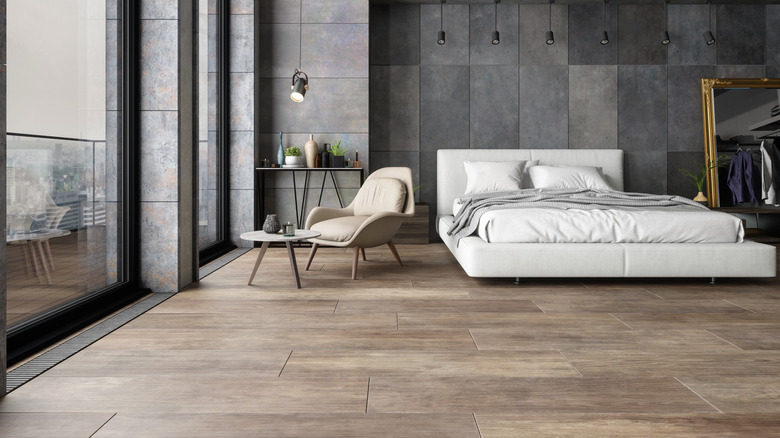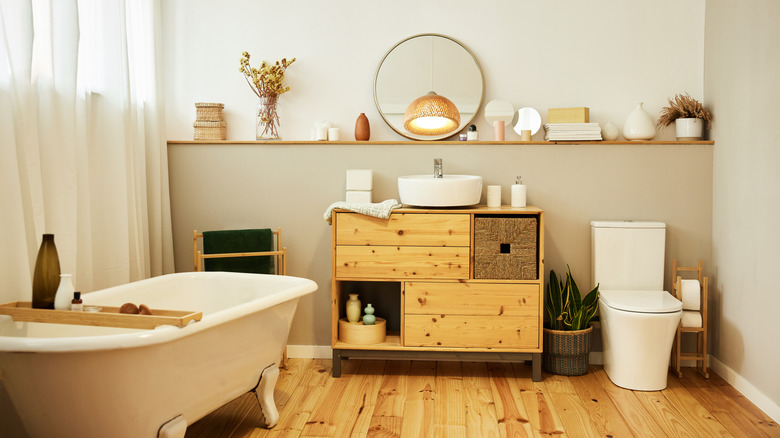The Best Kind Of Tile To Use For A Realistic Wood Floor Look
A hardwood floor is a classic design choice, but wood isn't a good fit for every environment. When you want the style and charm of wood but need more durability, wood-look tile can be the perfect option. However, the biggest visual difference between wood and tile flooring is the grout, which can make or break the final effect; so, the secret to making tile look more like authentic wood is to minimize the grout lines.
Rectified tile is manufactured using a process that gives it very exact edges. Because of this finish, the tiles can be fitted closely together, allowing for minimal grout lines — smaller than ¹⁄₁₆-inch. Traditional porcelain and ceramic tile are shaped and then fired in a kiln. In the process, it develops natural variations in size. These variations require thicker grout lines to set the tile, usually ⅛-inch.
Rectified tile is finished after the firing process, so the tiles are more uniform in size, and the edges are sharper. It's available from many different tile floor brands. With minimal grout lines and exact edges, the tile can better mimic the look of real wood. Choose a grout that closely matches the color of your tile to further enhance the illusion.
Benefits of rectified tile over wood
Water, pets, kids, spills, and scratches — in other words, life — can all damage your wood floors and leave them looking worse for wear. Rectified tile is much more durable. It's impervious to most scratches and quickly cleans up with a damp mop. So, you can take a pass on maintenance tasks, such as staining hardwood floors.
Wood-look tile should definitely be your go-to in situations where your floors are frequently exposed to water and high humidity, such as in a bathroom, kitchen, or basement. Wood is an organic material that absorbs moisture and will expand and contract based on the humidity level of your environment. Rectified tile is water-resistant, so you can splash and not give much thought to potential water damage.
Another great reason to choose rectified tile over wood is if you're watching your budget. You can easily save money using rectified tile compared to wood flooring. It's also comparable to the cost of luxury vinyl plank, although you'll likely pay more for installation. For some people, there's no substitute for real wood — and there's no denying that tile feels different underfoot — but if you need a more durable and affordable option, rectified tile can be a perfect fit.
Find a qualified tile contractor for realistic wood-look tile
If you've seen any of those DIY wood-look tile jobs with the seams all perfectly lined up, you understand the importance of finding a qualified professional to install the tile. It's even more important when you're trying to get as close as possible to the look of real wood flooring. The minimal grout technique requires a deft hand, and many traditional tile contractors may not have the necessary experience or know-how.
Start your search as you would for finding any home remodeling contractor — by asking for referrals. Whether you're admiring someone's gorgeous floors in person or online, if you see one that looks amazing, reach out and ask for the name of their contractor. You can also ask your local tile retail store for referrals if you aren't getting any good leads from your family and friends.
Online reviews can help you pick a qualified contractor, but look for reviews that specifically mention wood-look tile or plank installation. When you've narrowed down your search to two or three contractors, ask for referrals and examples of their work — again, ask to see jobs that demonstrate their experience with rectified tile and thin grout lines. Pay close attention to details such as alignment and spacing. When you're talking to referrals — don't be tempted to skip this step — ask how the tile job has held up over time.


